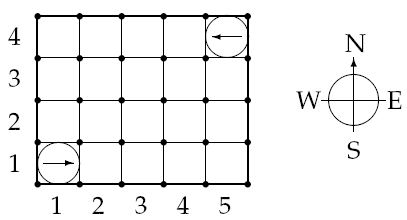POJ2632--Crashing Robots(模拟)
来源:互联网 发布:微课录屏软件有哪些 编辑:程序博客网 时间:2024/06/05 21:53
Description
In a modernized warehouse, robots are used to fetch the goods. Careful planning is needed to ensure that the robots reach their destinations without crashing into each other. Of course, all warehouses are rectangular, and all robots occupy a circular floor space with a diameter of 1 meter. Assume there are N robots, numbered from 1 through N. You will get to know the position and orientation of each robot, and all the instructions, which are carefully (and mindlessly) followed by the robots. Instructions are processed in the order they come. No two robots move simultaneously; a robot always completes its move before the next one starts moving.
A robot crashes with a wall if it attempts to move outside the area of the warehouse, and two robots crash with each other if they ever try to occupy the same spot.
Input
The first line of input is K, the number of test cases. Each test case starts with one line consisting of two integers, 1 <= A, B <= 100, giving the size of the warehouse in meters. A is the length in the EW-direction, and B in the NS-direction.
The second line contains two integers, 1 <= N, M <= 100, denoting the numbers of robots and instructions respectively.
Then follow N lines with two integers, 1 <= Xi <= A, 1 <= Yi <= B and one letter (N, S, E or W), giving the starting position and direction of each robot, in order from 1 through N. No two robots start at the same position.

Finally there are M lines, giving the instructions in sequential order.
An instruction has the following format:
< robot #> < action> < repeat>
Where is one of
L: turn left 90 degrees,
R: turn right 90 degrees, or
F: move forward one meter,
and 1 <= < repeat> <= 100 is the number of times the robot should perform this single move.
Output
Output one line for each test case:
Robot i crashes into the wall, if robot i crashes into a wall. (A robot crashes into a wall if Xi = 0, Xi = A + 1, Yi = 0 or Yi = B + 1.)
Robot i crashes into robot j, if robots i and j crash, and i is the moving robot.
OK, if no crashing occurs.
Only the first crash is to be reported.
Sample Input
4
5 4
2 2
1 1 E
5 4 W
1 F 7
2 F 7
5 4
2 4
1 1 E
5 4 W
1 F 3
2 F 1
1 L 1
1 F 3
5 4
2 2
1 1 E
5 4 W
1 L 96
1 F 2
5 4
2 3
1 1 E
5 4 W
1 F 4
1 L 1
1 F 20
Sample Output
Robot 1 crashes into the wall
Robot 1 crashes into robot 2
OK
Robot 1 crashes into robot 2
题意
一个图里有很多个机器人,机器人可以动
只有在上一个机器人动完,下一个才可以动
机器人会碰墙或者撞到其他机器人
输出第一次碰撞
思路
模拟
没有什么奇技淫巧。
给的方位比较坑
不是正常的方位 比如图中的(5,4)
代码
#include <cstdio>#include <iostream>#include <map>#include <cstring>using namespace std;const int maxn = 105;int n,m,A,B;int G[maxn][maxn];int dir[4][2] = {{-1,0},{0,-1},{1,0},{0,1}};map<char, int > mp;bool flag;struct node{ int x; int y; int d;}rob[maxn];void init(){ mp['N'] = 0; mp['W'] = 1; mp['S'] = 2; mp['E'] = 3;}void gao(int a, char b, int c){ if(b == 'L') { rob[a].d += c; rob[a].d %= 4; } else if(b == 'R') { c = c % 4; rob[a].d = (rob[a].d - c + 4)%4; } else { G[rob[a].x][rob[a].y] = 0; while(c--) { rob[a].x += dir[rob[a].d][0]; rob[a].y += dir[rob[a].d][1]; if(rob[a].x > 0 && rob[a].x <= m && rob[a].y > 0 && rob[a].y <= n) { if(G[rob[a].x][rob[a].y] != 0) { printf("Robot %d crashes into robot %d\n",a,G[rob[a].x][rob[a].y]); flag = 1; break; } } else { printf("Robot %d crashes into the wall\n",a); flag = 1; break; } } if(!flag) G[rob[a].x][rob[a].y] = a; }}int main(){ int t; init(); int a; char b; int c; cin >> t; while( t -- ) { flag = 0; cin >> n >> m; cin >> A >> B; memset( G, 0, sizeof(G)); for(int i = 1; i <= A; i ++) { cin >> rob[i].y >> a >> b; rob[i].x = m - a+1; rob[i].d = mp[b]; G[rob[i].x][rob[i].y] = i; } for(int i = 0; i < B; i ++) { cin >> a >> b >> c; if(flag) continue; gao(a,b,c); } if(!flag) printf("OK\n"); }}- (模拟)poj2632 Crashing Robots
- POJ2632--Crashing Robots(模拟)
- POJ2632 Crashing Robots(模拟)
- POJ2632--Crashing Robots--模拟
- POJ2632-Crashing Robots(模拟)
- POJ2632《Crashing Robots》方法:模拟
- POJ2632 Crashing Robots 模拟题
- POJ2632,Crashing Robots,模拟法,繁
- poj2632 Crashing Robots 模拟水题
- poj2632 Crashing Robots (手动模拟) 9.20
- Crashing Robots POJ2632
- poj2632 Crashing Robots
- POJ2632 Crashing Robots
- poj2632--Crashing Robots
- POJ2632 Crashing Robots
- poj2632 Crashing Robots
- poj2632 Crashing Robots
- poj2632 Crashing Robots
- 实现一个简单的java集合框架
- bam文件softclip , hardclip ,markduplicate的探究
- Tensorflow 机器翻译NMT笔记 1 快速上手
- 拆分
- bzoj 3333: 排队计划 树状数组+线段树
- POJ2632--Crashing Robots(模拟)
- google检测是否数据发送完成
- nmap学习
- 解决thinkPHP3.2.3使用Smarty模板后无法使用系统常量问题!
- C# Dictionary和SortedDictionary简介
- 线程
- 将项目部署到阿里云服务器ECS总结
- Qt 中的智能指针
- 利用Dockerfile构建镜像


